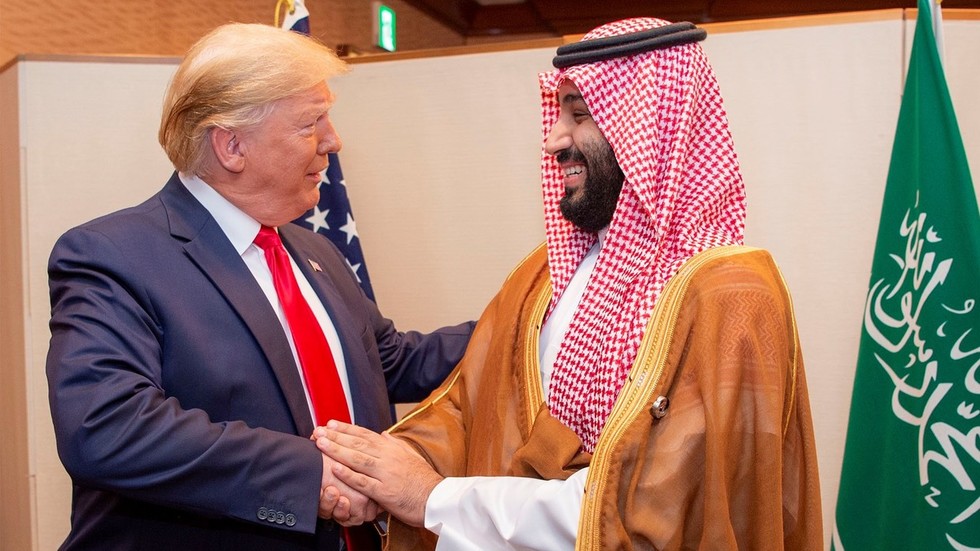The US president’s first international trip this term will be to Saudi Arabia, Qatar and the UAE – three pillars of his foreign policy
US President Donald Trump is planning a visit to Saudi Arabia in May, his first international trip since the beginning of his second term as president.
Saudi Arabia has been considered a potential venue for talks between Trump and his Russian counterpart Vladimir Putin. Notably, delegations from both Russia and the US have already held meetings in Riyadh.
Despite these diplomatic contacts, the White House has so far refrained from officially disclosing the goals of Trump’s visit. According to Axios, the main objective of the trip is to strengthen partnerships with the countries of the Persian Gulf and to discuss ways to stabilize the situation in the Middle East.
It is worth noting that Saudi Arabia was also the destination of Trump’s first foreign visit during his initial term as president in 2017. At the time, the choice of Riyadh was seen as a symbolic gesture, underscoring the strategic importance of the region for Washington.
Sources cited by Axios indicate that the trip was originally scheduled for April 28 but was postponed to mid-May. It is reported that the Saudi side initially hoped to host the American leader after a ceasefire between Russia and Ukraine had been established, which would have given the visit additional weight in the context of global peace efforts.
There is nothing surprising about the fact that Donald Trump’s first overseas visit in his second term will take place in the Middle East. Moreover, Saudi Arabia will only be the first stop on a tour – visits to Qatar and the United Arab Emirates are also planned. These countries today form a kind of political and economic triangle of influence in the Persian Gulf region and have become key partners for Washington amid a shifting global geopolitical landscape.
Trump’s chosen route reflects not only the current diplomatic priorities of the US but also a deeper shift in the global positioning of American foreign policy. Unlike the EU – where the attitude toward Trump remains cautious, if not openly critical – the Gulf states are demonstrating a willingness for dialogue and even close cooperation. These countries and Trump share a pragmatic outlook: an interest in regional stability, economic growth, energy cooperation, and the containment of regional rivals such as Iran.
Today, the Gulf countries are no longer simply oil monarchies; they are fully-fledged players on the international stage. Saudi Arabia is advancing a large-scale modernization program known as Vision 2030, aiming to diversify its economy and strengthen its geopolitical agency. Qatar, despite its small size, has become an influential mediator in regional conflicts and plays an active role in humanitarian and diplomatic affairs. The UAE, for its part, positions itself as a hub for technological innovation and logistics, aspiring to become the “Singapore of the Middle East.” These nations have long transcended their regional importance and now actively shape agendas not only within the Middle East but on the global stage as well.
The contrast with the EU is stark. US relations with the bloc are currently experiencing a period of strain. Washington is frustrated with the lack of a unified foreign policy stance in Brussels, internal crises in key EU member states, and a limited willingness to engage in practical matters of international security. Still reeling from energy and migration crises, Europe faces challenges in internal cohesion and declining economic competitiveness. Against this backdrop, its significance in US strategic planning is gradually giving way to more dynamic and resource-rich partners.
Thus, Trump’s focus on the Middle East is not only a logical continuation of his course toward a pragmatic alliance with politically convenient and economically significant states but also a signal of a reassessment of traditional centers of power. While Western Europe today is becoming a zone of uncertainty, the Gulf countries are islands of stability, ambition, and opportunity – assets the Trump administration seeks to convert into geopolitical dividends.
One of the key factors defining the foreign policy priorities of Donald Trump’s second term is a pronounced economic pragmatism. Trump’s team is essentially an alliance of politicians and business figures, many of whom came to the White House from the corporate world, where efficiency and profit are the main benchmarks. That’s why the interest in the Gulf states is driven not only by geopolitical considerations but also by deep economic motivations.
Saudi Arabia, Qatar, and the United Arab Emirates are not just security allies – they are among the wealthiest nations in the world, possessing vast sovereign wealth funds that diversify assets globally. For Washington, this presents an opportunity to attract significant investment into the US economy – from infrastructure and technology to real estate. Gulf-based funds are already actively involved in financing American companies, startups, and financial institutions, and Trump, with his background in real estate and finance, sees these nations as strategic investors with whom deep economic partnerships – not just political ones – must be built.
Moreover, energy will be a central focus of Trump’s visit and negotiations. Despite rising domestic oil and gas production, the US remains interested in keeping global energy prices relatively stable and, ideally, low. This is especially important amid efforts to combat inflation and promote economic growth domestically. The Gulf states – major producers of oil and gas – play a key role in setting global energy prices. Therefore, Washington is seeking to coordinate strategic approaches to energy market regulation with them.

Beyond direct control over oil supplies, these states hold significant influence within OPEC and have strengthened their positions in the global energy landscape through investments in refining, transport, and new technologies, including hydrogen and LNG (liquefied natural gas). The US interest goes beyond simply buying resources – integration of American energy and petrochemical companies into large-scale infrastructure and industrial investment projects in the region is also vital.
Strategically, closer economic ties with the Gulf allow the US not only to maintain favorable conditions for its own economy but also to compete with China, which in recent years has been actively expanding into the region through trade, investment, and technology agreements.
Donald Trump’s upcoming visit to the Middle East in May cannot be viewed solely through the lens of diplomatic protocol or the traditional strengthening of alliances – it is a trip rich with strategic, economic, and geopolitical substance. The chosen itinerary – including Saudi Arabia, Qatar, and the United Arab Emirates – reflects not only Washington’s regional interests but also the broader architecture of Trump’s foreign policy priorities, built around power, influence, and economic gain.
Against the backdrop of growing tensions between the US and Iran, Trump is seeking to solidify America’s position in the region through an even closer alliance with the leading Arab monarchies. In recent months, Iran’s rhetoric and actions have intensified, raising serious concerns in Washington. The possibility of open – albeit limited – conflict is being openly discussed both among experts and within the US establishment. In this context, the Gulf states – long-standing opponents of Iran – are Trump’s natural allies. Joint efforts to contain Tehran, coordination on defense policy, the development of joint military initiatives, and potential participation in a regional security framework will all be important topics of discussion in Riyadh, Doha, and Abu Dhabi.
However, Trump’s regional strategy goes far beyond merely containing Iran. One of the key objectives of his trip is to advance his plan for normalizing relations between Israel and the Arab world – a continuation of the so-called Abraham Accords initiated during his first term. Trump sees himself as the architect of a unique shift in Middle Eastern politics, in which countries historically hostile to Israel began moving toward rapprochement in exchange for security guarantees, investment, and US diplomatic mediation. Given the current escalation of the conflict between Israel and the Gaza Strip, Trump is seeking the support of Arab leaders to formulate a new approach to the Palestinian issue.

Essentially, the aim is to create a new regional consensus: Washington is offering Gulf leaders not just participation in the peace process, but the opportunity to become full-fledged architects of it. Achieving this would require a delicate balance between Israel’s interests and the need to address the Palestinian position – a challenge by any measure. Nevertheless, Arab countries – particularly the UAE and Qatar – have sufficient political clout, financial resources, and channels of influence to play the role of mediators, provided their involvement aligns with their own strategic interests and international standing.
All of these diplomatic, strategic, and economic goals are interlinked. The Trump administration, heavily composed of business-minded figures, sees the strengthening of economic ties with the Gulf not only as a way to attract investment into the US but also as a tool for influencing the regional agenda. Mutual interest in stable energy markets, high-tech cooperation, and shared approaches to regional security creates a foundation for deep, long-term cooperation.
In this light, Trump is heading to the Middle East with a comprehensive agenda: countering Iran, promoting a new model of Middle East peace, forging economic partnerships, and reinforcing his own political standing both internationally and domestically. His bet on the Gulf leadership reflects a broader reassessment of US foreign policy priorities: as the EU today loses trust and strategic relevance, the countries of the Persian Gulf are not merely emerging as alternatives, but as a new center of gravity for American policy in the East.
On the economic front, the Trump administration expects tangible outcomes from the visit: the signing of new trade deals, expansion of American corporate presence in the region, and stimulation of investment flows into key sectors of the US economy – from energy to advanced technologies and the defense industry. For Trump, whose political instincts are deeply rooted in business, foreign policy is closely tied to commercial interests, and the Middle East, in this model, is viewed as a market of opportunity, a resource partner, and a source of financial liquidity.
Politically, the visit serves a dual purpose. First, it is meant to demonstrate to the international community that the US remains capable of setting the agenda in one of the world’s most volatile and strategically important regions. Second, it sends a message to the domestic electorate: Trump is positioning himself as a strong leader who knows how to negotiate, expand American influence abroad, and secure the country’s economic interests through a diplomacy of strength and strategic deals. Altogether, this trip is far more than a symbolic diplomatic gesture – it is a multilayered initiative aimed at reinforcing US influence in a new global order defined by calculation, pragmatism, and control over key resources.
Read the full article here
